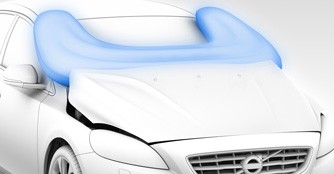Volvo's work on pedestrian protection wins award
04 Jun 2013|4,327 views
Prof. Lotta Jakobsson, Senior Technical Specialist Safety at Volvo Cars Safety Centre, received the prize at the Enhanced Safety of Vehicles (ESV) Conference in Seoul, South Korea, a couple of days ago. She also held a presentation about Volvo Cars' outstanding achievements within pedestrian protection and presented a paper on the Pedestrian Airbag Technology equipped in the new Volvo V40.

The most serious head injuries involving pedestrians and cars are caused by the hard structure under the bonnet panel, the windscreen's lower edge and the A-pillars.
In 2010, Volvo launched Pedestrian Detection with full auto brake. The system can avoid a collision with a pedestrian at speeds of up to 35km/h if the driver does not respond in time. At higher speeds, the focus is on reducing the car's speed before the collision.
In order to mitigate the consequences if a collision with a pedestrian is unavoidable, the Volvo V40 - launched in 2012 - comes equipped with the world's first Pedestrian Airbag Technology.
The bonnet hinges are equipped with pyrotechnical release mechanisms which pull out a pin and release the rear of the bonnet - inflating the airbag at the same time. During the inflation sequence, the airbag raises the bonnet by ten centimetres and stays in position. The added gap between the bonnet and the hard components in the engine compartment gives space for the bonnet to deform, absorbing energy and dampening the impact of the pedestrian's head and chest.
Prof. Lotta Jakobsson, Senior Technical Specialist Safety at Volvo Cars Safety Centre, received the prize at the Enhanced Safety of Vehicles (ESV) Conference in Seoul, South Korea, a couple of days ago. She also held a presentation about Volvo Cars' outstanding achievements within pedestrian protection and presented a paper on the Pedestrian Airbag Technology equipped in the new Volvo V40.
"The purpose of the world's first airbag for pedestrians is to help protect these vulnerable road users in certain situations when they impact the bonnet and the area around the windscreen, where there may be a risk of serious head injuries," said Lotta Jakobsson.
The most serious head injuries involving pedestrians and cars are caused by the hard structure under the bonnet panel, the windscreen's lower edge and the A-pillars.
In 2010, Volvo launched Pedestrian Detection with full auto brake. The system can avoid a collision with a pedestrian at speeds of up to 35km/h if the driver does not respond in time. At higher speeds, the focus is on reducing the car's speed before the collision.
In order to mitigate the consequences if a collision with a pedestrian is unavoidable, the Volvo V40 - launched in 2012 - comes equipped with the world's first Pedestrian Airbag Technology.
The bonnet hinges are equipped with pyrotechnical release mechanisms which pull out a pin and release the rear of the bonnet - inflating the airbag at the same time. During the inflation sequence, the airbag raises the bonnet by ten centimetres and stays in position. The added gap between the bonnet and the hard components in the engine compartment gives space for the bonnet to deform, absorbing energy and dampening the impact of the pedestrian's head and chest.
Latest COE Prices
August 2025 | 2nd BIDDING
NEXT TENDER: 03 Sep 2025
CAT A$104,524
CAT B$124,400
CAT C$72,190
CAT E$125,001
View Full Results Thank You For Your Subscription.





















